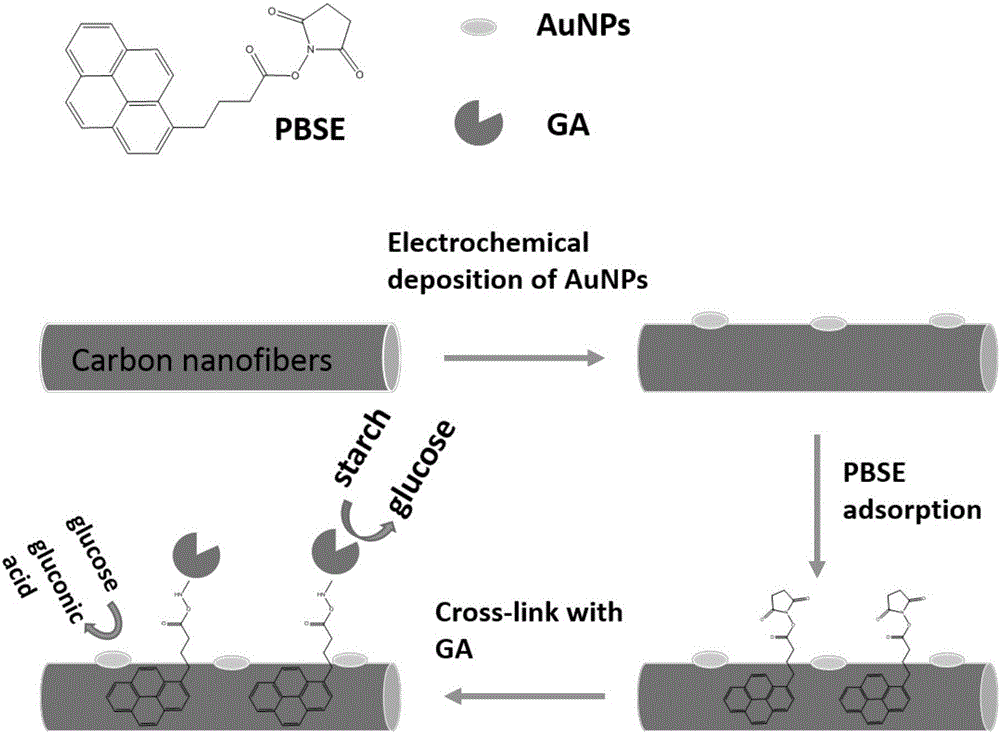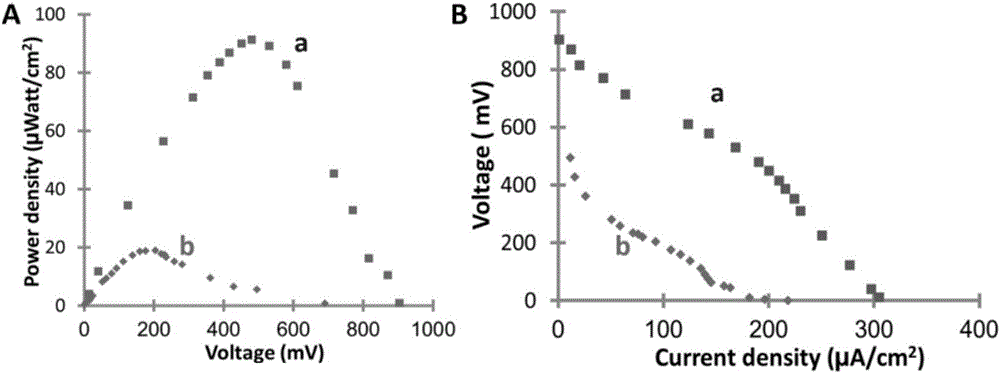Glucoamylase and nanogold co-doped carbon nanomaterial hybrid anode-based starch biofuel cell
A technology of biofuel cells and carbon nanomaterials, applied in the direction of regenerative fuel cells, fuel cells, battery electrodes, etc., can solve the problems of incomplete oxidation substrates, short battery life, difficult to maintain enzyme activity, etc., to achieve excellent operation and The effect of storage stability
- Summary
- Abstract
- Description
- Claims
- Application Information
AI Technical Summary
Problems solved by technology
Method used
Image
Examples
Embodiment 1
[0036] 1.1 Reagents:
[0037] Glucoamylase (GA); N-hydroxysuccinimide ester 1-pyrene butyric acid (pyrenebutanoic acid succinimidylester, PASE); trihydrate chloroauric acid (HAuCl 4 ·3H 2 O); carbon nanofibers (CNFs); dimethylformamide (Dimethylformamide); phosphate buffer saline pH7.4 (PBSbuffer); phosphate buffer saline pH5.5 (PBSbuffer).
[0038] 1.2 Preparation of carbon nanofiber-modified glassy carbon electrodes (AuNPs / CNFs / GCE) deposited on the surface of AuNPs
[0039] 1) The glassy carbon electrode with a working area of 0.3 mm in diameter was thoroughly ground and polished with alumina powders of 0.3 and 0.05 microns in diameter, and then ultrasonically cleaned in absolute ethanol and deionized water, and then dried with nitrogen gas for later use.
[0040] 2) 6-8 μl of CNFs dispersed in DMF solvent with a concentration of 3mg / ml was drop-coated on the surface of the glassy carbon electrode, and the electrode was dried in a 37°C convection oven for two hours.
...
Embodiment 2
[0050] 2.1 Anode structure characterization and performance
[0051] In order to achieve efficient electrochemical catalysis of glucose on the electrode surface under neutral solution conditions, a pure gold nanoparticle surface with a large number of catalytically active sites on the surface is indispensable. Therefore, at first the present invention adopts the method of direct electrochemical deposition to modify the surface of CNFs without any protective groups, pure AuNPs on the surface, characterized by scanning electron microscopy ( figure 2 A) It can be seen that the prepared AuNPs, with a diameter of about 8-13nm, are uniformly distributed on the surface of CNFs. At the same time, it can be seen that the electrode surface modified by CNFs is a three-dimensional cross network structure with micro-nano holes, which can not only effectively improve the catalyst loading, but also facilitate the solution diffusion and mass transfer process on the electrode surface. In add...
PUM
| Property | Measurement | Unit |
|---|---|---|
| diameter | aaaaa | aaaaa |
| diameter | aaaaa | aaaaa |
| diameter | aaaaa | aaaaa |
Abstract
Description
Claims
Application Information
 Login to View More
Login to View More - R&D
- Intellectual Property
- Life Sciences
- Materials
- Tech Scout
- Unparalleled Data Quality
- Higher Quality Content
- 60% Fewer Hallucinations
Browse by: Latest US Patents, China's latest patents, Technical Efficacy Thesaurus, Application Domain, Technology Topic, Popular Technical Reports.
© 2025 PatSnap. All rights reserved.Legal|Privacy policy|Modern Slavery Act Transparency Statement|Sitemap|About US| Contact US: help@patsnap.com



